小总结
Tips
- 居里夫人发现镭,将其涂在钟表上作为夜光钟表;钷147Pm作为夜光材料, 但也由于它是人工放射性元素 , 因 而也未被广泛使用。
- OSL能量和thermal energy的对比:It is to be noted that the optical and thermal energies needed for the release of trapped carriers are not the same. 参考[Thermally and Optically Stimulated Luminescence: A Simulation Approach]
- 共掺杂的Ln3+选择:Most often, Eu2+ is introduced as the recombination center, while the afterglow is extended by addition of other trivalent rare earth ions. In particular, Nd3+, Dy3+ and Tm3+ are often the best choices, although this is still to large extent a phenomenological observation. [Extending the afterglow in CaAl2O4:Eu,Nd persistent phosphors by electron beam annealing-OME-2012]
- OSL公司,好的OSL综述[Fundamentals of Materials, Techniques, and Instrumentation for OSL and FNTD Dosimetry]
- 长余辉缺陷来源:There are two main groups of point defects that can be formed in a host: (i) the intrinsic (Schottky or Frenkel), thermodynamically formed during heating of the material; and (ii) extrinsic, formed by the insertion of alio- or even isovalent (co-)doping. [Dalton Transactions 49.45 (2020): 16386-16393."Abnormal co-doping effect on the red persistent luminescence SrS:Eu2+, RE3+ materials." Dalton Transactions-2020]
- 共掺杂(异价离子)的作用:It is believed that the co-dopant can act in two ways, even simultaneously in some cases. The aliovalent co-dopant increases the lattice defect concentration due to charge compensation or stabilizes some intrinsic defects. Also, they act as electron–hole trapping sites, depending on their position relative to the valence and conduction bands. [Dalton Transactions 49.45 (2020): 16386-16393."Abnormal co-doping effect on the red persistent luminescence SrS:Eu2+, RE3+ materials." Dalton Transactions-2020]
- 简单分类hole/electron trap:
-
- Electron Trapping-Detrapping 和 Hole Trapping-Detrapping [Persistent luminescence instead of phosphorescence: History, mechanism, and perspective-JL-2019]
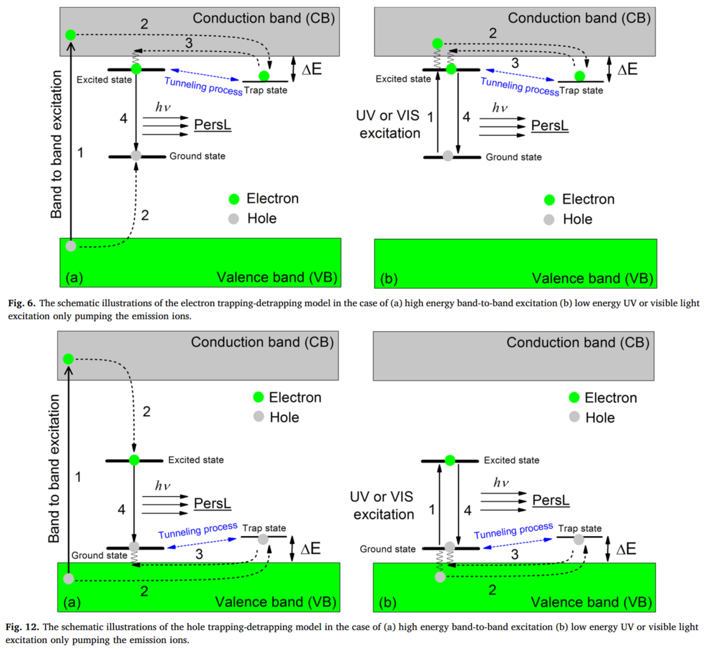
- 判定是electron trap而不是hole trap起作用(这里的PSL就是OSL):Upon UV exposure, only the electrons excited into higher 4f65d1 states can be captured by traps below. If the traps are hole traps, the holes produced in the ground state of Eu2+ can enter the valence band of the host to fall into the hole traps. This process should not be influenced by the electrons either in higher or the lowest lying excited states of Eu2+, implying PLE and PSL charging spectra are identical. 参考[OL-2013]
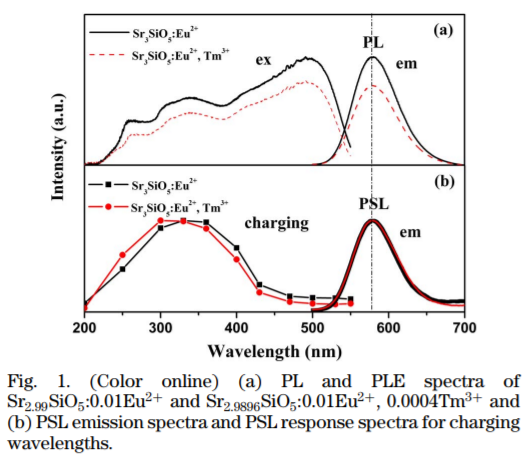
- Electron Trapping-Detrapping 和 Hole Trapping-Detrapping [Persistent luminescence instead of phosphorescence: History, mechanism, and perspective-JL-2019]
-
- 好的中文综述:
PLE/TL/OSL测试
TL基本概念:用ionization radiation 或者non-ionization radiation去激发样品,然后能量会存储在样品中,通过加热样品,实现“read-out”,加热过程中得到的黑体辐射之外的发光就是TL发光。
OSL基本概念:和TL类似,只是后面“read-out”的步骤是通过特定波长的光激发来实现的,让被缺陷俘获的载流子释放。
- 测量长余辉/OSL材料的激发谱:the photo-charging effect may induce serious excitation spectrum distortions. 参考[OM-2003]
- 长余辉材料激发谱的测试,变狭缝/积分时间都会有影响,参考[Charging curves and excitation spectrum of long persistent phosphor SrAl2O4:Eu2+, Dy3+-OM-2003]
- Thermoluminescence excitation spectroscopy,参考[Thermoluminescence excitation spectroscopy: A versatile technique to study persistent luminescence phosphors-JL-2011]以及[Thermoluminescence as a Research Tool to Investigate Luminescence Mechanisms—Materials—2017]
Lumilab系列
Eu2+ Persistent Luminescence-Review
为了对长余辉材料有一个初步的认识,我们先学习一下[Persistent Luminescence in Eu2+-Doped Compounds: A Review-Materials-2010]
小知识
- phosphorescent : a quasi-stable state is involved, causing an increased lifetime of the fluorescence decay,其寿命也不超过1秒,这一点区别于长余辉。
- SrAl2O4:Eu2+,Dy3+不同的合成方法,在发光峰的位置以及长余辉的性能方面都有差异。
- 2O不加它的SrAl2O4:Eu2+,Dy3+长余辉很弱
(3) 加了B2O3 - 2MgSi2O7:Eu共掺杂其他三价稀土对长余辉没有帮助,这一点不同于Sr2MgSi2O7:Eu和Ba2MgSi2O7:Eu
- grain size影响 both the brightness and lifetime of the afterglow.
- sulfides长余辉材料,hygroscopic吸湿的,相比于铝酸盐和硅酸盐,稳定性更差,但是其长余辉波长更长,黄/橙/红色均有,这和centroid shift有关,This increased red shift is mainly determined by a larger centroid shift for sulfides than oxides, which is due to a larger covalency between the anion and the Eu2+ ion.
- Ca2Si5N8:Eu2+热稳定性很好,也不吸湿,存在非常弱的intrinsic长余辉,但是可以通过共掺杂Tm3+实现一个小时长余辉。
- PL的最佳掺杂浓度和长余辉的不同,不同情况下codopant的最佳浓度也不同。常用做法是1% Eu2++ 1% Ln3+(2 % Ln3+)。
- TL曲线的校准:如果想反映实际的TL曲线,因为实测TL是真是反映其长余辉的真实性能的。如果要计算trap的深度,必须用变温发射光谱校正一下,除非该样品在TL测试范围内热稳定性很好,比如Cr3+(高温下,尖峰快速变弱,但是宽峰变化较慢),Mn4+的热稳定性比Cr3+差,但是150 ℃下仍有80 %的强度。另外热稳定性的温度校正涉及两个参数,一个是温度系数,一个是浓度系数(不同浓度,猝灭不一样)。
- 散热膏(thermal paste):也称导热膏,是一种导热性良好(但多半不导电)的膏状物质。散热膏的作用是除去截面部位的空气/间隙(空气导热性差),以让导热率提升。
- TL测试范围:TL的max温度为225-230 ℃,地理组的为400-500 ℃。
Estimating Trap Depths
深缺陷和浅缺陷:
- 0.4 eV以下的浅缺陷,在室温下被捣空了,对长余辉没有贡献。
- 2 eV以上的深缺陷,不参与室温下的长余辉,因为它需要的thermal energy太大了。
- 0.65 eV被认为是室温长余辉的最佳陷阱深度。
(1) 经验公式:$$E_{T}=T_{m} / 500$$
(2) Rand and Wilkins方法(单一缺陷能级)$$\begin{array}{l} I \propto s n \cdot \exp \left(-\displaystyle\frac{E_{T}}{k T}\right) \\\displaystyle\frac{\beta E_{T}}{k T_{m}^{2}}=s \cdot \exp \left(-\displaystyle\frac{E_{T}}{k T_{m}}\right) \end{array}$$存在的问题:
(a) \( s\)- frequency factor未知,而且很影响最终结果。人们常将其近似为vibrational frequency of the lattice。Chen说了\( s\)其实和温度有关,但是很多文献中都默认和温度无关(比如OSL-OME)。
(b) 忽略了retrapping,或者可能是second-order。
(c) The relation holds exactly for first-order kinetics but for other kinds of kinetics it is a good approximation. [Lanthanide energy levels in YPO4-RM-2008]
(3) Hoogenstraaten 方法:绕开\( s\)的uncertainty的问题,选用不同的升温速率\( \beta_{i}\),然后利用\(\ln \left(T_{m i}^{2} / \beta_{i}\right)\) versus \(1 / T_{m i}\)作图,拟合出一条直线,通过斜率就可以算出激活能。
(4) Initial Rise Method: 解决了detrapping的问题,只关注low-temperature side of the TL peaks,但是也不太准确,因为it is often very difficult to isolate the initial rising part of a glow peak, making the obtained trap depths less accurate.
(5) Chen方法:可以避免order不明的问题,即提出了general order kinectics,他的方法考虑了TL peaks的形状,对于不同的情况,他给出了不同的公式。
(6) Chen and McKeever -1997方法:$$E=2.52 k T_{\mathrm{m}}^{2} / \mathrm{FWHM}-2 k T_{\mathrm{m}}$$assumes that the charge transfer can be described by first-order kinetics and the trap can be characterized by two trapping parameters, \(s\) (\(s^{-1}\)), a preexponential factor (assumed to be temperature independent) and the trap depth or activation energy \( E\) (eV). [Lanthanide energy levels in YPO4-RM-2008]
(7) GlowFit软件: [Lanthanide energy levels in YPO4-RM-2008]
(a) not only a few points of the glow peak are used but the whole measured glow curve by fitting the TL intensity to a mathematical description of the glow peak.
(b) uses the well known Randall–Wilkins equation (first-order kinetics equation describing the TL intensity as function of temperature, 1997) to fit to experimental points using the least squares Levenberg–Marquardt method.
小总结:
- 不同的方法,得到的缺陷深度不同,所以比较缺陷深度的时候,应该用同样的计算方法,这样才可以比较。
- TL峰的overlap,让缺陷深度的分析更加不准确。
- TL Glow Curve Analyzer软件:集成了first, second and general order kinetic equations。
Persistent Luminescence Mechanisms
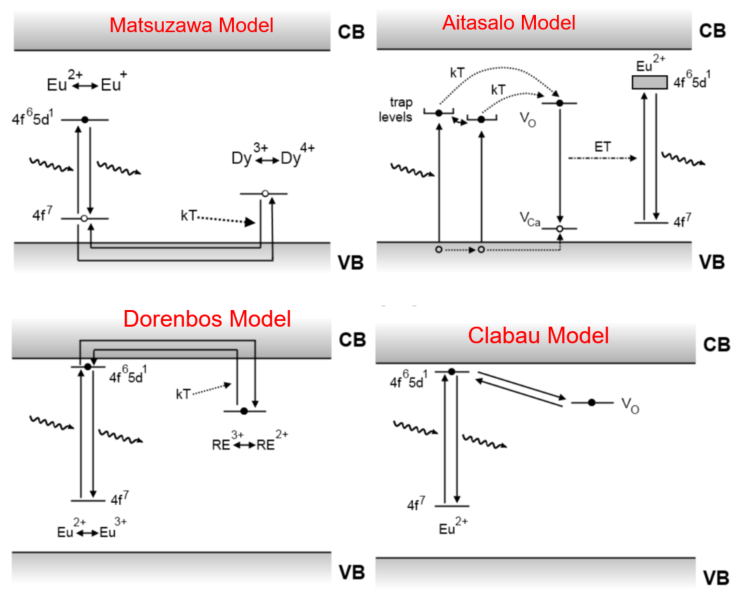
Matsuzawa model:空穴转移模型
- 霍尔效应和光电导,证实hole是charge carriers。
- 不能很好地解释没有共掺杂Dy3+的样品的长余辉机理。
- Eu+和Dy4+化学上很难稳定存在。
Aitasalo model: 能量传递模型
- traps来自自身基质,共掺杂三价稀土离子使得这些缺陷数量增加。
- 共掺杂Sm3+余辉变弱,是因为Sm3+容易被还原为Sm2+,使得长余辉缺陷减少。
- 氧空位和Ca空位与临近Eu发生作用。
- CaAl2O4:Eu2+,Nd3+
- 此模型把氧空位和阳离子空位分别归结为稳定的电子陷阱和空穴陷阱,对后续余辉机理研究提供了重要的参考。但是,此模型认为氧空位与阳离子空位是直接进行载流子复合的,没有能量损失,这要求两种缺陷在空间上比较接近,其实是十分困难的。
Dorenbos model: 电子陷阱模型
- 稀土离子的能级是localized,而不像CB和VB中的delocalized布洛赫波。
- 稀土离子被激发后,不能被看作一个“real hole”。
- 不认可前面证实hole是charge carriers的光电导实验。
- 不能解释非共掺杂样品的长余辉。
- Dy2+的基态能级位于CB之下0.9 eV,和实验结果数量级相同。
- 解释了共掺杂Sm3+或者Yb3+强烈降低了长余辉,因为陷阱更深了,室温下难以释放。
Clabau model: 氧空位模型
- EPR实验表明,激发的时候Eu2+浓度减小,去激发之后Eu2+浓度增加,说明Aitasalo model不对。
- 没有导带参与。
- 电荷转移发生在Eu和临近lattice defects之间(为了降低体系能量,氧空位在晶格中应尽可能与发光中心Eu2+相邻,这种与发光中心相邻的氧空位是余辉发光的关键)。
- 光电导实验并没有显示在detrapping的过程中电流增大。
- SrAl2O4:Eu2+,Dy3+以及没有共掺杂Dy3+的样品TL峰的形状一样,所以chemical nature of the trap was not influenced under codoping。
- 共掺杂三价稀土,可以形成更多的氧空位缺陷,和稀土的ionization potential有关。
- 空位模型能够解释还原气氛下制备的Eu2+激活的碱土铝酸盐材料的长余辉现象,但对于氧空位浓度很低的余辉材料,如空气气氛下合成的CaTiO3: Pr3+等氧化物,很难用氧空位模型解释。
Aitasalo new model: 缺陷相互作用,形成complex aggregates。
关于模型的小tips:
- Sr2MgSi2O7:Eu2+,Re3+,用X射线近边吸收XANES,发现Eu2+和Eu3+都存在,只发现有Re3+(不能证实Dorenbos/Matsuzawa的model)。不过这也有可能是因为filled traps的浓度太低了,有些离子探测不到。上述模型也没有说明多少浓度的缺陷参与长余辉。
- Dorenbos的模型在YPO4:Ce3+,RE3+中符合得很好,但是在其他材料中就不一定了,很少有材料的trap depth满足Ln2+的GS的变化trend。
- 长余辉的激发光谱和PL的激发谱可能不一样,在建立模型的时候也必须考虑这一点。当然,长余辉发光的激发谱不是很好测试。
Challenges and Perspectives
- 2O4:Eu2+,Dy3+
- 目前缺乏黄色、橙色和红色的长余辉材料,主要原因是:
(1) Eu2+对于氧化物材料的晶体场而言,往往强度不够产生红光发射。于是可以转向其他掺杂离子比如Eu3+或者Mn2+,比如经典红色长余辉材料Y2O2S:Eu3+,Mg2+,Ti4+。
(2) Purkinje effect,是人类眼睛对高度照明灵敏,而在低照明水平时,往光谱高频蓝端迁移的现象,也就是说视见函数的变化。红色长余辉材料必须比绿色长余辉材料发光强很多倍,我们肉眼才可以在黑暗中感受到相同的亮度。 - 长余辉的机理目前仍未清楚,但是人们都认为the general mechanism of charge carriers getting trapped in long-lived energy levels inside the band gap.
- 研究机理最好的测试手段:XANES、EXAFS、EPR。
Luminescence and x-ray absorption SrAl2O4:Eu,Dy : Evidence for valence state changes
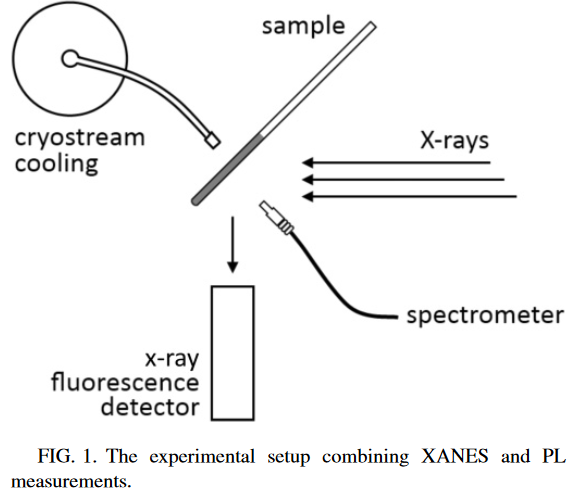
实验:同时进行X射线吸收谱(XAS)的测试和radioluminescence (RL)的测试SrAl2O4:Eu,Dy。RL用来研究X射线辐照下的charging behavior;XANES用来研究charging过程中Eu和Dy的价态变化。冷却系统120 K is sufficiently low to keep all trap levels filled due to the lack of thermal energy to induce the recombination process leading to the afterglow.
目标:
(1) 展示XAS可以用于研究长余辉荧光粉中离子的价态;
(2) show that a valence state change upon filling the traps in SrAl2O4:Eu,Dy occurs for the dopant (Eu) but not for the codopant (Dy).

RL结果:
- This characteristic charging behavior is due to the competition between the fast photoluminescence process and the energy storage, i.e., the occupation of trap states.
- \(I_{\mathrm{RL}}(t)=I_{\mathrm{RL}, f}(1-F(t))\)
-
- \(I_{\mathrm{RL}, \mathrm{f}}\)表示最终的RL强度
- \(F(t)\)对应于上面的红色的线,describes how many excitations in the phosphor are not used for (radio)luminescence but instead lead to the filling of trap states.
-
- \(F(t)=A_{1} e^{-\frac{t}{\tau_{1}}}+A_{2} e^{-\frac{t}{\tau_{2}}}\)
双指数的两个components可能对应于two types of trap centers. - Then the total number \(n\) of trapped charge carriers at a given time \(t_{1}\) is proportional to $$n\left(t_{1}\right) \approx \int_{0}^{t_{1}}\left(A_{1} e^{-\frac{t}{\tau_{1}}}+A_{2} e^{-\frac{t}{\tau_{2}}}\right) d t=\tau_{1} A_{1}\left(1-e^{-\frac{t_{1}}{\tau_{1}}}\right)+\tau_{2} A_{2}\left(1-e^{-\frac{t_{2}}{\tau_{2}}}\right)$$成立的条件:
(1) there is no thermal emptying of traps during the illumination;
(2) no fading, tunneling, or other nonradiative recombination occurs. - 上图的蓝线表示的是缺陷填充比例随时间的关系,表达式为\(n(t) / n_{f}\),分母表示的是最终填充的缺陷数量。只需要80秒,就可以填充90 %的缺陷。
- 120 K下的RL只观察到Eu2+和微弱的Dy3+的发光,没有Eu3+;在相同温度下的PL只观察到Eu2+的发光。
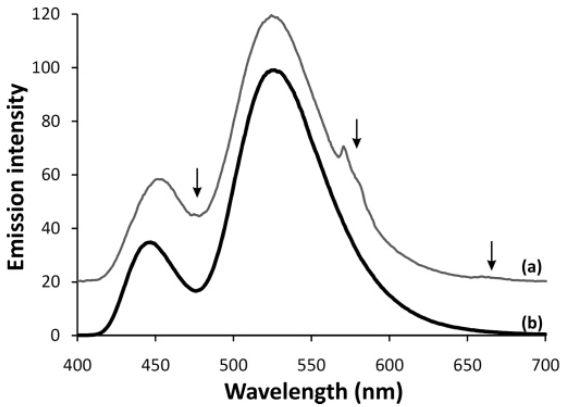
XANES结果:
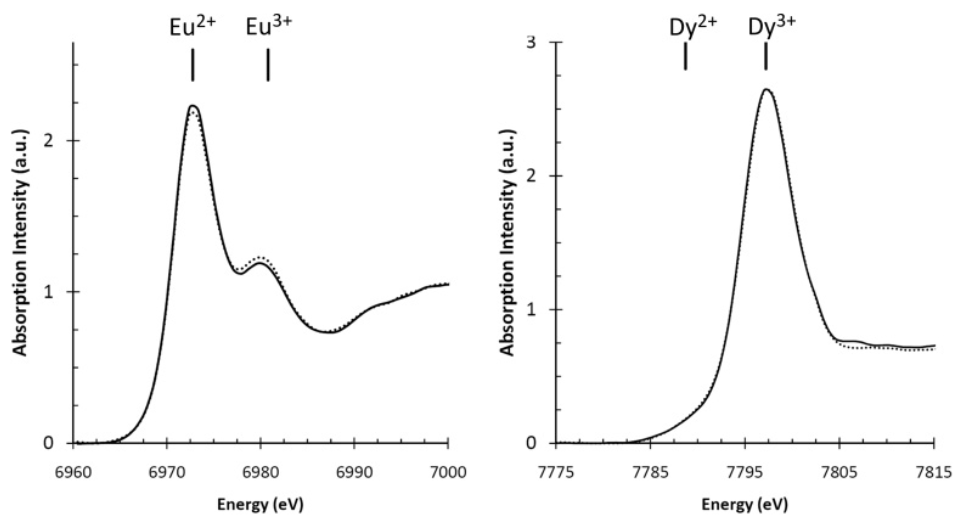
- 少量的Eu2+经过120 K下的X射线辐照120秒后,变为Eu3+,但是并没有观察到对应的Dy3+的变价。
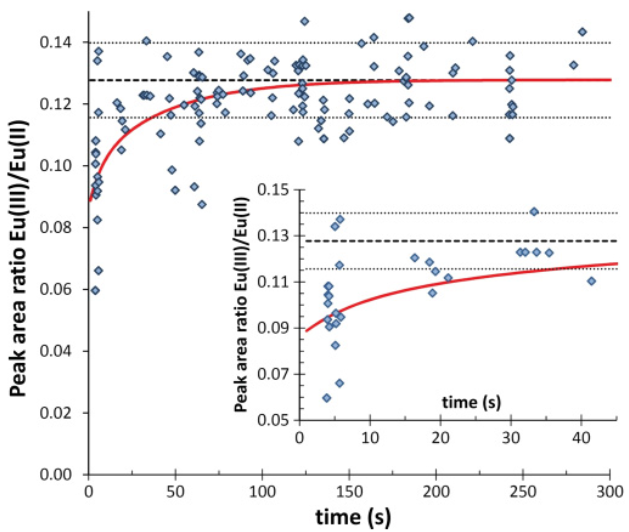
- \(P_{R}(t) \cong P_{0}+c \displaystyle\frac{n(t)}{n_{f}}\)
-
- \(P_{0}\) is related to the fraction of Eu3+ which is present in the material, irrespective of the fraction of filled traps.
- \(P_{R}(t)\)表示的就是XANES peak area of Eu3+ and the one for Eu2+,也就是上图纵轴的。
-
讨论
上述测试表明辐照之后Eu3+对应的peak area大约增加了4 %,which indicates a change in valence state of a fraction of Eu ions in the same order of magnitude. 之前有的人通过X射线吸收谱观察到Eu3+/Eu2+的比例没有变化,然后得出结论说no Eu3+ could be involved in the trapping process,Rather, the formation of a Eu2+-hole (h+) pair seemed more plausible。
Our results show that, despite these previous observations, there is ionization of Eu2+ to Eu3+ during charging. However, the ionization can only be observed on a short time scale due to the high x-ray flux which almost immediately charges the phosphor.
Dy的价态:测试过程中并没有观察到Dy的价态变化,No Dy2+ or Dy4+ was observed at any point of the charging process. 可能的情况:
(1) It seems that the electrons are trapped by defects in the host material (possibly vacancies) rather than by the codopant itself.
(2) Another possibility is the formation of a Dy3+-electron pair, which would cause the electron to be trapped without an actual reduction of the codopant ion.
(3) Also, it is possible that reduction of the Dy3+ takes place, but only for a minor fraction of the codopant ions, remaining undetected by regular XANES measurements.
原位RL测试的好处:即使像铝酸锶这样的很好的长余辉材料,X射线辐照下trap的填充也只需要大约1分钟。Hence x-ray absorption techniques should only be used with sufficient care to study changes in the valence state of dopants in persistent phosphors, especially for phosphors with less trapping capacity. In situ monitoring of the RL behavior, as was performed in this work, is advisable to assess the influence of the x-ray beam on the charging of the persistent phosphor being studied.
X射线辐照得到的Eu3+来源:One could argue that the formation of Eu3+ is a result from the x-ray radiation and is not related to the charging process of persistent phosphors. However, we verified on other Eu2+ doped nonpersistent luminescent materials that no Eu3+ could be detected after x-ray irradiation. (测试了SrS:Eu2+样品)
辐照初始阶段测到了Eu3+的XANES信号:
(1) X射线辐照填充很快速,所以it is not possible in the present setup to determine directly whether Eu3+ is already present in thermally emptied SrAl2O4:Eu,Dy, simply because in the used setup it is not possible to measure the XANES region on the subsecond time scale.
(2) 确实可能有some fraction of Eu3+ present at the start of the measurement. 一方面辐照之前的加热可能not sufficient to release all the trapped electron. 另一方面也可能a certain amount of Eu3+ is present in the material, irrespective of the illumination of the phosphor. 因为The presence of both valence states Eu2+ and Eu3+ would not be surprising, taking into account the low reduction potential of europium. Even though the dopant and codopant are usually added to the host crystal in their trivalent state (R2O3 or RF3 being the most common choices), the reductive atmosphere under which the samples are prepared is able to reduce most of the Eu. However, the present XANES results show that this reduction is possibly not complete. For dysprosium the reduction potential is about 2 eV higher, explaining why all codopant ions are in a trivalent state.
长余辉机理:During the charging of SrAl2O4:Eu,Dy an ionization of Eu2+ to Eu3+ clearly occurs, indicating that electrons are the relevant charge carriers, in contrast to several earlier models. The electron is, however, not trapped onto Dy3+ to form Dy2+, as the applied XANES experiments are considered to be sufficiently sensitive to detect the possible formation of Dy2+. Hence, the model involving the electron capture by Dy3+, as proposed by Dorenbos, seems not appropriate for SrAl2O4:Eu,Dy. Nevertheless this model based on the position of the rare earth’s energy levels within the band gap has shown strong predictive character for the thermoluminescence behavior of Ln3+-doped phosphates, assuming the electron trapping by Ln3+ ions. The model by Clabau et al., where the electron is trapped at a nearby defect (presumably an oxygen vacancy), is compatible with the XANES and RL results. In this model the role of Dy3+ is a stabilization and deepening of the electron traps already present in SrAl2O4:Eu. To construct more quantitative energy level models, effects of (Coulomb) interaction between the ionized europium and the nearby trapped electron, along with relaxation effects, should be included.
Trap Distribution-PRB
CaAl2O4:Eu常被用作a standard material for persistent luminescence investigations的原因:
(1) a single europium site;
(2) afterglow duration也足够长;
(3) 合成简单;
(4) trapping process is not thermally activated至少PRB温度范围内(比如Eu掺杂nitridosilicates的trap填充过程与温度关系较大)。
常见的五种估算trap depth的方法:
(1) initial rise methods, based on the initial fraction of the glow curve;
(2) area methods, based on the area under the glow curve;
(3) peak position methods, based on the location of the maximum;
(4) shape methods, based on the shape and symmetry of the curve;
(5) curve fitting methods, computerized or using a series expansion.
新方法:变化激发时间和激发温度 + initial rise analysis
(1) 变化激发时间,可以给出kinetics的信息(文中研究的材料的trap深度和激发的时长无关);
(2) 如果激发时间不变,那么在高温激发温度下得到的缺陷能级更深,在低温激发温度下得到的缺陷能级更浅;
(3) The difference between the integrated TL intensities at two different excitation temperatures is a measure for the number of available traps between the depths estimated for these two measurements。
Four kinds of kinetics
First order kinetics
- every charge carrier that manages to escape a trap immediately produces luminescence and is not captured by another trap.
- an exponential afterglow decay profile and an asymmetric TL glow peak with a negative skew.
- 最强峰的位置和辐照剂量无关。比如在[Lanthanide energy levels in YPO4-RM-2008]中To test the first-order kinetics assumption all samples were exposed to doses varying from 8 up to 2048 mGy. It was observed that for all samples all glow peaks show their maxima at the same temperature for the different doses indicating that the first-order approximation is justified.
- possibility of retrapping = possibility of recombintaion
- \((1+t)^{-2}\) afterglow decay profile and more symmetrical TL curves.
- 特别注意“从起点出发,虽然回家了,但是不回到起点”。the escaped charge carriers can be captured by neighboring traps with different activation energies than the one they escaped from.
拓展:设发光体是由于异号载流子(电子和空穴)的复合而被激发,在激发停止时如果两种载流子数量各为\(n_0\)个,在激发\(t\)时间后,载流子数目为\(n \),这时有\(dn/ dt=-pn^2\),其中\(p\)为复合速率常数,积分可得\(\frac{1}{n}-\frac{1}{n_{0}}=p t\),于是\(n=\frac{n_{0}}{1+p n_{0} t} \),那么\(I \propto p n^{2}=\frac{p n_{0}^{2}}{\left(1+p n_{0} t\right)^{2}}\),当\(t\)很大时,近似有\( I \propto t^{-2}\)。实际长余辉发光幂指数不是-2,而是-1和-2之间。[固体发光讲义-许少鸿]-P14
- in between first order and second order.
- a purely mathematical interpolation, lacks a straightforward physical meaning.
Tunneling kinectics
对应\(t^{-1}\) kinetics,但这种kinetics对应两种情况:
-
- continuous trap depth distribution (温度依赖)不要求均匀分布,只要几个\(kT\),约100 meV。
- tunneling 更可能深缺陷(无温度依赖)速度很慢,所以测TL的时候看不出影响,可能是超长余辉的来源。[Zhengwei Pan_scientific report_2013]的例子如下:
 (1) LiGa5O8:Cr3+样品77 K下的长余辉(室温下charging,然后马上放到液氮里面测),来源于tunneling。
(1) LiGa5O8:Cr3+样品77 K下的长余辉(室温下charging,然后马上放到液氮里面测),来源于tunneling。
(2) Both Templer and McKeever and Chen have argued that if a tunneling process occurs in the phosphor, it is more likely from the deeper-lying trap states. [Olivier_ECS_2018]
(3) tunneling对TL的影响would be more pronounced on the high-temperature side of the TL peak. [Olivier_ECS_2018]
(4) tunneling要求复合中心和缺陷临近, if defects are situated near the recombination centers, i.e. the Eu3+ ions, tunneling is the only recombination path at low temperature. [Philippe_JL_2012]
(5) Y3Al2Ga3O12:Cr3+,254 nm,10 K下激发样品,在200K以下也存在TL强度,但是如果在10 K下保持1个小时,那么先前200 K以下的TL强度就不见了,indicative of radiative recombination by athermal tunneling from trapping centers nearby Cr3+ in this material. [Tanabe-OME-2016]
Broad TL glow peaks 的处理:are often fitted to three or more individual glow peaks obeying general order kinetics. 存在如下问题
(1) 要拟合的参数太多了,不太可靠。每一个峰包含5个参数,缺陷深度/ 频率因子/ 缺陷浓度/ 初始填充的缺陷浓度/ order;
(2) 得到的结果physical interpretation impossible。
Trap distribution
- fewer parameters to be accurately described than a multitude of discrete energy levels.
- a continuous distribution of trap depths is a more intuitively acceptable description of the actual defect situation
- 三种类型:uniform, exponential, and Gaussian profiles
缺陷深度变化的来源
- the structure of the lattice surrounding the trapping center may exhibit random variations in the nearest neighbor bond angles and bond lengths.
- association of the trapping centers with other defects in the vicinity is possible.
- the distance from the traps to the luminescent centers.
Initial Rise Analysis
这种方法假定在TL曲线的低温段,trapped charge concetration认为是常数(浓度),此时对于first/second/general order kinetics的TL,我们都可以近似处理得到:$$I(T)=C \exp \left(\frac{-E_{T}}{k T}\right)$$
\(C\)中包含frequency factor,和温度无关,为了准确性,只取\(I< 0.15I_{\text{max}}\)的部分。以\(\ln(T)\)为纵坐标,以\(\displaystyle\frac { 1 }{ T }\)为横坐标作图得到的斜率即为\(E_T\)。对于a continuous trap depth distribution,这种方法得到的\(E_T\)反映的是depth of the shallowest occupied traps in the distribution。
这样处理的好处:
(1) independent of the order of kinetics;
(2) 只考虑TL的一小段,TL峰的overlapping可以reduced greatly;
(3) 给出 shallowest occupied traps 的深度。
不适用的情况:two largely overlapping peaks
Tm-Tstop
A previously irradiated specimen is first heated at a linear rate to a temperature \(T_{\text {stop }}\) corresponding to a position on the low-temperature tail of the first glow-peak. The sample is then cooled rapidly to room temperature and then re-heated at the same linear rate in order to record all of the remaining glow-curve. The position of the first maximum in the glow-curve is then noted. The whole process is repeated (on a freshly irradiated sample) using a different value of \(T_{\text {stop}}\) each time. 这个停止温度每次增加2-5度。下图是first-order,图b的阶梯不是那么严格,因为TL峰存在overlap。[McKeever_PSS_1980]

TL excitation spectra
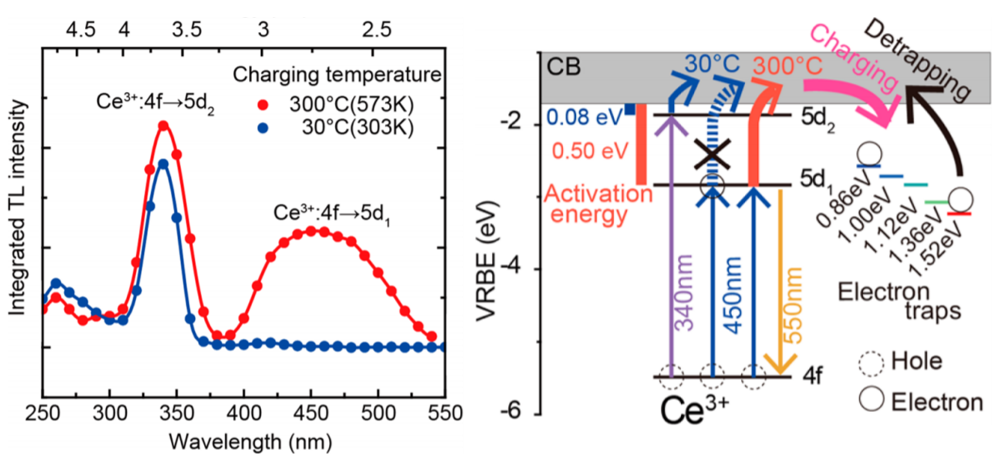
上图来自[Jumpei Ueda_JPCC_2015],在文献 [Philippe_JL_2012]中作者称之为“trap filling spectrum”,该文献中也谈到the trap filling spectrum of CaAl2O4:Eu,Nd is very similar to the steady state excitation spectrum, pointing at the proximity of the lowest 5d excited state to the bottom of the conduction band and the absence of a thermal barrier for trapping (at least around room temperature).。当然我们也知道后面的PRB也证实这个thermal barrier for trapping只有在很低的温度下才表现出来。
探测器和黑体辐射
暗电流:TL测试的时候出现low temperature decay below 100 K is due to change in dark current of the Si CCD detector。
黑体辐射:rises in high temperature above 500 K are due to the increase of black body radiation in NIR range.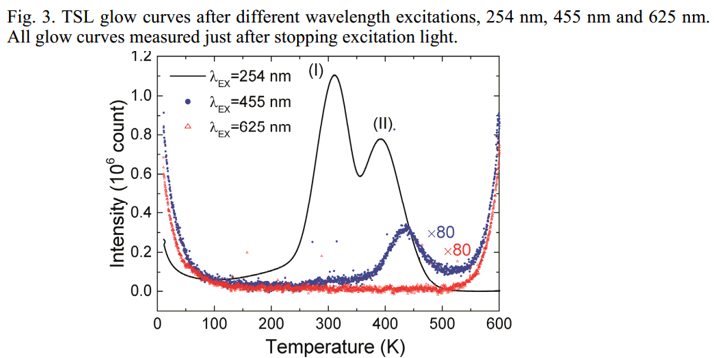
Localized transition model
Trapping and detrapping in SrAl2O4-变波长/温度-PRB
长余辉性能比较:
2O4:Eu2+长余辉几分钟
(2) SrAl2O4:Eu2+,Dy3+长余辉几个小时
(3) SrAl2O4:Eu2+,Dy3+
长余辉机理研究存在的问题:
(1) whether the traps are related to host defects, the trivalent codopant, or a combination of both?
(2) role of the conduction band?
(3) whether tunneling processes also play a role ?
先前别人对于trapping和detrapping的研究只考虑了下列的一个或两个方面:(应该三方面统筹考虑)
(1) charging behavior (发光强度不是一下子稳定达到最大)
(2) afterglow (emission intensity slowly decreases)
(3) TL
上述integrated experiment的好处:
(1) a better understanding of the trapping and detrapping processes
(2) transferable
研究不同波长下的trapping efficiency的意义:
(1) 不同应用场合,激发波长不同;
(a) 户外的长余辉材料,可以用NUV太阳光;
(b) bioimaging长余辉激发波长更长;
(2) 材料对不同激发波长的响应也不同。
现象:
(1) AC-LED荧光粉:通过长余辉补偿没有电的时候的发光,其实牺牲了QE,因为as not every trapped charge carrier eventually leads to an emitted photon。
(2) 温度越高的实验,glowcurve的初始强度越大,毕竟能量足够detrapping,但是a side effect is a faster decay。
(3) 温度非常低的实验,glowcurve很弱很弱,主要是trapped charge carriers被“冻”住了,出不来,只有非常少量的filled shallow traps的出现detrapping而发光。
(4) 实验温度越高,TL的峰就越往高温区移动。
Energy level scheme
基质中存在两种Sr的格位,低温下也观察到发射峰包含一个蓝光峰和一个绿光峰。关于峰的指认,不同的人不用的看法:
(1) 两个格位环境很相似,不至于发光有这么大差异;
(2) Eu2+的d轨道的择优取向;
(3) 4f基态到VB的charge transfer (hole detrapping)
(4) Eu2+更高的5d轨道的跃迁(低温下晶格振动非常弱)
作者用Dorenbos那一套计算,认为不同的发光来自不同的格位。
1.如何解释两个发光峰各自的斯托克斯位移相差很大?
答:作者分析了两个格位的对称性,给出了详细分析。
2.如何解释blue emission center发光容易猝灭?
答:画出能级图,该中心的5d距离导带更近,所以很容易猝灭。
Thermal quenching behavior
blue emission在275 K时完全猝灭,假设thermal ionization(thermal excitation of the 5d electron from the lowest 5d level to the conduction band) ,那么两种峰热稳定性的差异来自于其 unrelaxed 5d能级到CB底的距离。
在蓝光峰可见的情况下,绿光峰的来源:
(1) intrinsic green emission (“绿光格位”)
(2) ET from 蓝光格位 to 绿光格位 (温度非常敏感)
Charging behavior
charging过程的发光来源:regular PL & afterglow
传统解释charging:
(1) monotonic shape(增长曲线,然后稳定).
(2) competition between the steady state luminescence and the filling of traps.
(3) 注意这里的offset是因为激发光太强了,对于good persistent phosphor,如果charge的光不是很强,那么offset是很小的,老板在油管视频留言中解释了,这也和David的Acs结果match。
上述解释存在的问题:
(1) 极低温度(235 K,370 nm)下的charging过程,并没有出现“增长曲线”,而且反而是一个下降趋势。
(2) 作者认为该现象是由于只存在write in,没有read-out,因为thermal energy 不够;同时随着write-in越来越多,Eu3+也越来越多,因此Eu2+越来越少,即发光越来越弱。
(3) 的思考:因为后面别人的文献已经证实真正转化成Eu3+比例其实很低,所以根据David的文章,我倾向于认为随着write in的进行,虽然没有afterglow,但是存在由OSL产生的detrapping,我们知道OSL的效率最多50 %,因此在charging过程中,OSL的贡献越来越大,因此总的QE就越来越小。
如果认为detrapping的电子都导致发光,那么:
(1) emission intensity = detrapping + PL
(2) 在激发的时候:detrapping = OSL +afterglow
(3) 在停止激发的时候:detrapping = afterglow上述图片中的PL和afterglow比例的归属是有问题的,因为激发达到稳态下的detrapping的强度和关掉激发源后afterglow的强度是不同的。稳态下,trapped charge carriers一方面通过thermal energy实现detrapping,另一方面也通过OSL(read-out)实现detrapping。David的实验也证实这个OSL的吸收还是挺强的,所以关闭激发源,就不存在OSL那一部分的贡献了,所以来源于detrapping的发光其实是减弱了。那么图中的PL其实= (OSL(n个)-变为thermal detrapping(n个))+"真实PL"
Efficiency of the persistent luminescence
待补充
Afterglow and TL
370 nm和435 nm激发的区别:
(1) 435 nm在220 K下不能填充traps(TL没有强度),而370 nm即使在该低温下,也可以看见明显的TL峰。前者存在energy barrier for trapping的影响,温度太低的话就不能write-in;后者反正在实验的温度范围内,trapping proces不存在障碍。
(2) 253 K下,分别用不同波长激发,370 nm的TL显示更多的shallow traps被filled,而435 nm的TL显示更多的deep traps被filled;另外370 nm的afterglow存在(浅缺陷多),435 nm的afterglow几乎没有(浅缺陷少)。
Trapping mechanism
- filling traps的过程是wavelength dependent和temperature dependent;
- local model,也就是说Eu2+
- thermal barrier for trapping versus thermal barrier for quenching
In literature, this thermal barrier has been related to the thermal quenching behavior of the steady state luminescence: the higher the thermal quenching behavior, the less likely trap filling occurs upon excitation to the lowest 5d states of the Eu2+ or Ce3+ ions. The reasoning is that a higher thermal quenching temperature is related to a larger separation between the 5d levels of the lanthanide ion and the bottom of the conduction band.
点评:二者有联系,不过不等价;435 nm激发下,绿光峰350 K才出现猝灭,但是220 K以上就可以trapping了,即trapping所对应的thermal barrier远小于thermal quenching所对应的thermal barrier。
Dy3+的角色
在没有共掺杂Dy3+的样品中,也观察到了长余辉现象,说明intrinsic defects play a role。通过能级图,Dy2+的GS能级深度和室温下长余辉所需要的能量相匹配。可能存在两种Dy2+的格位,但是后的深度差别不大。Given the apparently local nature of the trapping, clustering of europium and dysprosium on specific lattice sites could explain the difference in trap depth distribution upon excitation with blue or near-UV light。
Sr2MgSi2O7:Eu,Dy by NUV light not only leads to charge trapping, but also to OS release of previously trapped charges and subsequent OSL. [Optically stimulated detrapping during charging of persistent phosphors-OME-2016]
Model assumption:
(1) local trapping
(2) Detrapping rate ∝ excitation intensity (can be true with low intensity?)
Storage capacity:
(1) Trap density
(2) Trap depth
(3) Sensitivity to optically detrapping at the excitation wavelength
Issues for Eu2+ persistent phosphors: (trial-and-error approach for optimization)
(1) Chemical nature of the traps
(2) Involvement of the CB(charge delocalization/ or locally)
(3) Role of trap distribution
(4) Possible detrapping and tunneling
Different approaches to study storage capacity:
(1) Afterglow decay curve (decay to 0.3 mcd/m2)
(2) TL curve (assess trap depth of certain traps/ complicated curves complicate the assignment of trap depths and order)
Typical OSL source (near)-infrared light (1-1.5 eV), can empty shallow traps. This energy is larger than the trap depth. The mechanism of absorption of OSL source is unknow, maybe color center absorption.
Charging changes absorption:
(1) YPO4:Ce,Sm, SrAl2O4:Eu,Dy, OSL phosphors, photochromatic phosphors.
(2) For CaAl2O4:Eu,Nd, electron traps for photochromism ≠ electron traps for persistent luminescence, while "equal" in Zn2GeO4:Eu
Why Sr2MgSi2O7:Eu,Dy ?
(1) One site for Eu, fewer parameters for the model.
(2) Outspoken thermal barrier to distinguish charging and OSL.(PRB的trap distribution文章室温及以上没有这个效应)
Local model (toy model)
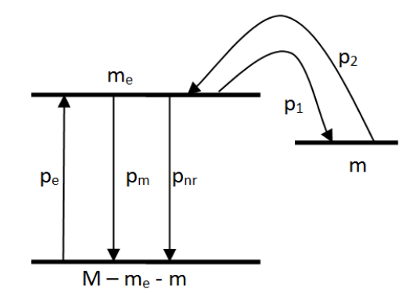
$$\begin{aligned} \frac{\mathrm{d} m_{e}}{\mathrm{~d} t} &=p_{e}\left(M-m_{e}-m\right)-\left(p_{m}+p_{n r}\right) m_{e}+p_{2} m-p_{1} m_{e} \\ &=-\left(p_{e}+p_{m}+p_{n r}+p_{1}\right) m_{e}+\left(p_{2}-p_{e}\right) m+p_{e} M \\ \frac{\mathrm{d} m}{\mathrm{~d} t} &=p_{1} m_{e}-p_{2} m \end{aligned}$$其中Thermally assisted (de)trapping: \(p_{1}=s \exp \left(-E_{1} / k T\right), p_{2}=s \exp \left(-E_{2} / k T\right)\)
Luminescent intensity: \(I(t)=p_{m} m_{e}(t)\)
This is a linear system which can be solved using eigenvectors and eigenvalues of the matrix representation.!
Dynamic equations for charging:
Initial state(boundary conditions): \(m(0)=m_{e}(0)=0\)$$\frac{d \mathbf{m}_{c h}}{d t}=\left[\begin{array}{cc} -\left(p_{e}+p_{m}+p_{n r}+p_{1}\right) & p_{2}-p_{e} \\ p_{1} & -p_{2} \end{array}\right] \mathbf{m}_{c h}+\left[\begin{array}{c} p_{e} M \\ 0 \end{array}\right]$$According to the method provided by MIT-微分方程3,we can get:$$\mathbf{m}_{c h}(t)=-p_{e} M \frac{v_{2 y}}{v \lambda_{1}}\left(1-e^{\lambda_{1} t}\right) \mathbf{v}_{1}+p_{e} M \frac{v_{1 y}}{v \lambda_{2}}\left(1-e^{\lambda_{2} t}\right) \mathbf{v}_{2}$$Dynamic equations for afterglow:
边界条件 \(\mathbf{m}_{c h}\left(t_{c h}\right)=\mathbf{m}_{a g}(0) \quad p_{e}=0\)。because \( p_{e}\) is very small, so the eigenvalues for the process of charging and afterglow can be seen equal. Therefore the general solution is: $$\mathbf{m}_{a g}(t)=c_{1} e^{\lambda_{1}^{\prime} t} \mathbf{v}_{1}^{\prime}+c_{2} e^{\lambda_{2}^{\prime} t} \mathbf{v}_{2}^{\prime} \approx c_{1} e^{\lambda_{1} t} \mathbf{v}_{1}+c_{2} e^{\lambda_{2} t} \mathbf{v}_{2}$$The two constant parameters can be determined by the initial conditions of afterglow. There is always a fast eigenvalue \( \left|\lambda_{1}\right| \geq p_{m}\) which can be observed as a stepwise increase at the beginning of the excitation or drop at the end of excitation.
(1) I don't understand the sentences highlighted in model page.
(2) Ignore the absorption of empty traps, which is also in David's-Acs photonics.
(3) 为什么辐照的突变强度和移除辐照的突变强度相等,数学上怎么看出来的?
(4) 冯昂:\(p_e \)是吸收截面x光通量,吸收截面对Eu2+来说通常在10-17--10-18 cm2,可测不同Eu2+浓度的线吸收系数来算吸收截面。在100 cm-1左右的吸收系数实验中比较常见。Eu2+的吸收比半导体的本征吸收系数小很多,通常小100-1000倍。通常现在的LED在低电流情形下,光通量达到1015 /(cm2 sec) 是比较容易的,所以\(p_e \)估计应该在10-3 量级。而文中将这个变化的量一律设为0,(改变LED电流就会改变\(p_e \)),使得模型有缺陷。浓度是从拟合里面算出来的,但是这个浓度量级上不太对 (跟Jose和David最近的文章 1016 /cm3也差的远)。假设1%的charging效率,那么charging完了后的电子浓度在108 /cm3量级。对应的发光光通量应该在探测器灵敏限下。\(p_e \)被大大低估。
Improved local model (OSL involved)

- \( \alpha\) is the ratio between the trap release cross-section and excitation cross-section of Eu2+。
- \(p_{1}, p_{2}, p_{n r}\) are temperature dependent。
- \( s\) frequency or attemptto-escape factor, temperature-independent, has to do with the fitting process, and it only shifts the final values of trap depth.
- \( p_{m}\) low temperature decay measurement, get lifetime 600 ns, so \( p_{m}\) is 1.66×106 s-1.
Explanation:
- \( \alpha p_{e}\) now is big enough, and its influence on the eigenvalue and eigenvectors can no longer be neglected. This explain why the initial jump at charging and drop after charging is differnet.
- dynamics of charging will depend in a more pronounced way on the excitation intensity due to the OSL term \(\alpha p_{e}\).
- Absorption rate increases during charing;because of the short lifetime of Eu2+, the numbers of it in excited state is very small \(p_{e}\left(M-m_{e}-m\right)+\alpha p_{e} m \approx p_{e} M+(\alpha-1) p_{e} m\)
- the maximum number of trapped charges will be limited.
- Match with the XANES result in SrAl2O4. Small ratio of Eu3+/Eu2+。
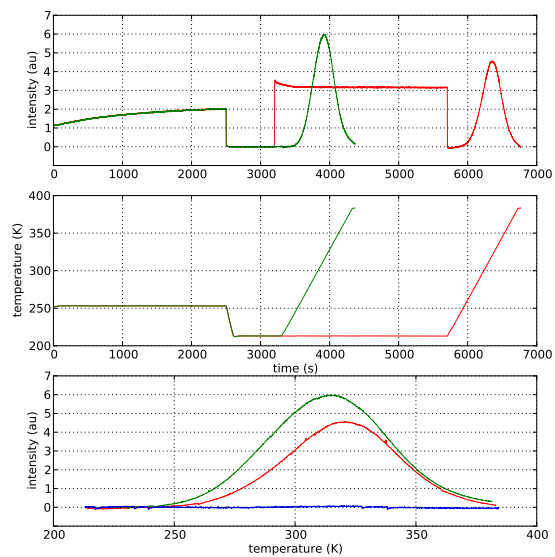
- 在253 K下charging,可以得到明显的TL峰(绿色),但是如果在213 K下charging观察不到TL峰,所以charging的效率和温度有关,即存在一个charge trapping的thermal barrier。只有温度足够高,才可以有效跨越这个barrier,实现对于缺陷的现充。
- 虽然213 K不能实现charge trapping,但是可以实现detrapping。左侧的图,就是在253 K下 先实现了charge trapping,然后降温到213 K,这个时候激发光只能实现detrapping。
- 总而言之,对于这里的同一激发波长,253 K下可以同时实现write-in和read-out (OSL)而213 K下,只能read-out,不能write-in。
问题: I know the thermal trapping barrier, but what's difference between thermal quenching barrier and trap depth energy?
Temperature and wavelength dependent trap filling-JL

- M2Si5N8都包含两种M格位,两个格位很相似,所以PL只看到宽带峰,无法区分。格位环境的不同(Eu周边相同的缺陷,但是深度略有差异),也会造成不同Eu相关的TL峰出现差异,于是出现实验结果的TL峰比较宽。但是长余辉过程的光谱,并没有显示出shape或者相对强度的变化,所以将TL宽化归因于不同格位的Eu证据不够充分。
- Eu2+在M2Si5N8的PLE可以分为两部分:
(1) 和bandgap有关:energies above or close to the (optical) band gap energy, electron–hole pairs or excitons are created, which can transfer their energy to Eu2+, after which radiative emission can occur. In general, this excitation pathway is not very efficient for Eu2+-doped compounds.
(2) 2+直接相关:4f6 - trap filling spectrum:也可以分为两部分,band gap excitation, higher and lower 5d levels,和PLE相比,靠近optical band gap(能量更低的)的波长更容易实现trap filling。对于5d激发态,更高的能级其filling trap效果更好。
The trap filling spectrum of CaAl2O4:Eu,Nd is very similar to the steady state excitation spectrum, pointing at the proximity of the lowest 5d excited state to the bottom of the conduction band and the absence of a thermal barrier for trapping (at least around room temperature). - 最佳trap filling的波长和band gap之间有差异,选择bangap附近的波长,反而不是很有效,作者没有给出合理解释。
- 热稳定性越好,和室温下可见光下trap filling的难度越大。知名的硅酸盐和铝酸盐长余辉材料也表现出较低的猝灭稳定(有利于trap filling)。
- 不能确认或者排除Tm3+是trapping center。
- thermal barrier,同一个东西,在不同实验表现出的数值上些许差异,但是变化趋势是一致的:
(1) PL thermal quenching
(2) photoconductivity
(3) trap filling - 实际应用的荧光粉,最好不是thermally actived process,不然填充效率太低了。
- Ca2Si5N8: Eu, Tm红色长余辉荧光粉,可以吸收可见光实现长余辉,那么更适合实际场景的应用,相比与Mn2+。
- 波长不改变填充trap的类型(深度),Given that the shape of thermoluminescence glow curves does not depend on the excitation wavelength, the same types of traps are being filled when exciting into the lower or higher 5d states of Eu2+. 所以作者在文章中也没有说这是一个localized system.
参考[David-JL-2020]
Deep Traps:
- useful in many applications such as dosimetry or optical memory storage;
- they could be expected to have little or no influence on the afterglow properties of (传统观点,实际错误)
通常的SrAl2O4:Eu2+,Dy3+的thermal cleaning 或者TL过程,只升温到200-250摄氏度
- 仪器限制
- 高温区的发光被猝灭,强度很弱,而且人们人问高温区的traps对室温长余辉没什么影响。
实验:
- 测试了荧光粉的热猝灭温度校正曲线,在300以上的曲线,作者用extrapolation的方法。
- 采用对数坐标反映TL曲线,不然高温段的弱峰被压制到看不见。
- 样品thermal cleaning到250度,再次测TL,那么室温到250度的TL没有发光峰,大多数人会认为真的把缺陷都捣空了。但是捣空之后,测TL,每次低温峰都不一样。
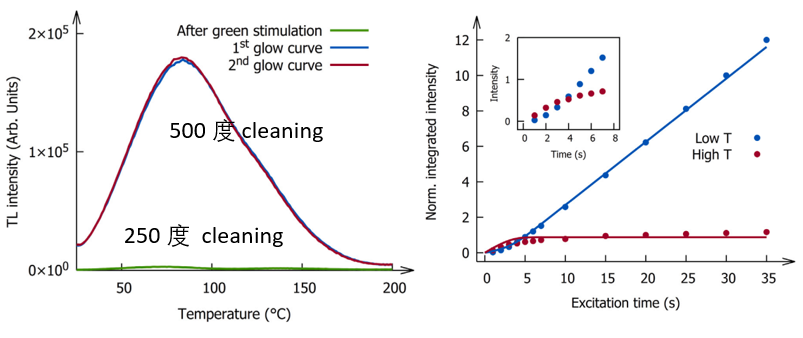
- Illumination with blue light transfers charges from deep to shallow traps,正如上面LiGa5O8:Cr3+荧光粉
- 但是作者用绿光去作用作用,发现这个效应very small。
option 2: competitive trap filling
- Preferential filling of deep traps at the expense of the filling of shallow traps;
- Filling of shallow traps is initially sublinear;
- Becomes linear when deep traps are filled.
Importance of Evaluating the Intensity Dependency of the Quantum Efficiency
参考[David-Acs-2017]
传统LED工作的时候,需要将交流电转换成直流电,否则会有flickering的问题。如果采用寿命更长的Mn2+的荧光粉(几个微秒),可以减弱这种效应,但是长寿命会带来饱和效应,使得LED的颜色随着功率的不同而不同。由于上述问题,人们提出了AC-LED荧光粉。
- 即使是非长余辉荧光粉,其trap也会影响其各种发光性质。The presence of trapping defects may alter other properties such as the phosphor’s quantum efficiency or the thermal quenching behavior.
- 简而言之,即使是非长余辉荧光粉,其trap也会影响发光。
对于LED荧光粉的要求:(为了提高量子效率)
- withstand high temperatures (trapped charge carriers在高温下会被释放)
- withstand high illumination intensities (trapped charge carriers可能通过OSL被释放)
OSL和upconversion的对比:
- 不考虑损失,二者的量子效率都是50 %
- OSL在很弱的光激发下也会发生,但是upconversion需要较强的激光,这样才能保证激发态的粒子数目足够产生明显上转换。
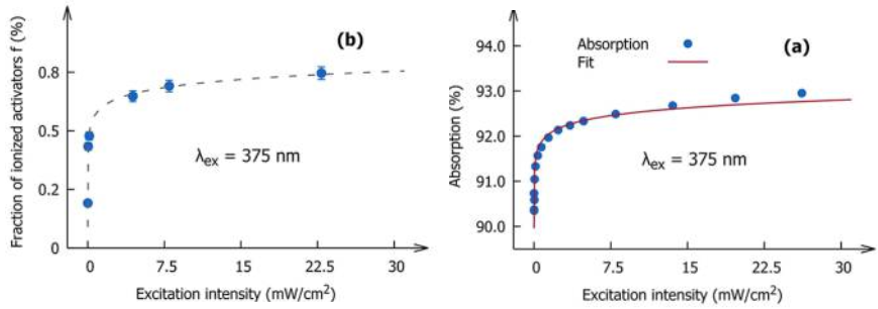
SrAl2O4:Eu2+,Dy3+随着激发光强度的增加,荧光粉的absorption要么remain constant,要么降低(饱和效应),与这里的实验结果不一样。Model如下:
- 只有Eu2+和filled traps才会吸收激发光,不考虑Eu3+以及empty traps对激发光的吸收。
- 平均吸收截面:\(f \times a_{\mathrm{tr}}+(1-f) \times a_{\mathrm{Eu}^{2+}}\),前者表示filled traps的贡献,后者表示Eu2+的贡献。
- 根据David自己的数光子的文章,可以算出不同激发强度下的\(f\),于是就可以利用含有两个未知数的表达式去拟合吸收强度的数据。这里作者给出了两个吸收截面的比值,但我感觉应该可以给出具体数值(作者后面测吸收光谱,也算出了所有的波长下的吸收截面)。
- 平这里的phosphor in polymer,由于要定量测量吸收截面,所以为了减小样品对于光线的scattering(要模拟出晶体的效果),所以作者选取了低的荧光粉浓度8 mg/cm2
- \(I=I_{0} \exp (-\sigma L n)\),指数项里面包含了吸收截面,光线穿过的样品的路径长度,以及浓度,作者都在文中有描述。
传统观点:(推测)荧光粉的存储能力it is only limited by the number of activator centers that have access to traps. 也就是说可以将Eu2+分为两类,一类(active)是可以和traps发生interaction的,这部分既可以贡献PL也可以贡献长余辉;另一类(inactive)Eu2+和traps没关系,只表现出PL。
存在的问题:如果上述观点成立,那么我们将在charging curves看到inactive的那一部分贡献的a nonzero offset。事实上,作者通过实验证发现不存在上述offset。
新观点:所有的Eu2+都可以和trap发生作用,这样才能解释no offset;长余辉存储电子的能力受到OSL的影响。这里,激发光写入能量的过程中也在read-out存储的信息(能量);有点类似爱因斯坦发光辐射理论,光子一方面可以被基态的离子吸收,使得系统能量增加,另一方面,也会发生受激辐射跃迁,使系统能量降低。
启示:
(1) 那些似乎"看不见"的缺陷,也会影响QE,所以对于LED荧光粉要尽可能消除缺陷。
(2) 为了让长余辉荧光粉有更大的存储电子(能量)的能力,要选择合适的激发波长,避免很强的OSL效应。
(3) 比较长余辉要用相同的激发波长+强度,It(SOL) might also complicate the comparison of literature data for a specific compound, as the obtained trap distribution might depend on the excitation conditions, such as the excitation wavelength and the intensity. [Philippe-OME-2016]
关于offset: But for a good persistent phosphor, like SrAl2O4:Eu,Dy or CaAl2O4:Eu,Nd, which is in a state with all the traps (thermally) emptied, you can do the following experiment: excite it with a constant light intensity and monitor the light output. For a non-persistent phosphor, you will then have an (almost) immediate and constant emission intensity. For those 'good' persistent phosphors, like SAO or CAO, you will observe no luminescence at all in the first seconds, after which the emission intensity starts to increase, to reach a plateau only after 10s of seconds (if the excitation intensity is not too high). This shows imo that initially every excitation leads to trapping and that all the europium ions (the sources of the trapped electron) participate in the trapping process, at least they are all contact to (possibly mutual) traps. For other phosphors with lower trapping capacity, one finds an offset with this experiment, i.e. an immediate rise to 90% of the final value, and then a small build-up. For those phosphors, it seems not all luminescent ions are connected to traps. [Philippe-油管-2020]
Adding memory to pressure-sensitive phosphors
ML
(1) destructive
(2) non-destructive (elastic deformation)也叫作elastico-mechanoluminescence
应用
(1) stress distributions/ microcrack propagation/ structural damages indication
(2) the visualization of ultrasound/
(3) the mapping of personalized handwriting
应用的限制
(1) emission colours有限
(2) the need for dark conditions
(3) the restriction to real-time measurements
(4) limited signal visibility
pressure memory (P-MEM) property:样品先用UV辐照,然后球形的棒子在上面画线(附加压力),部分浅缺陷和中等深度的缺陷中的电子跑到了深缺陷中,即压力使得电子的分布发生了redistribution。当然了,压力也使得深缺陷和中缺陷的电子更快释放,虽然看似剩下的缺陷中的电子数目总数减小了,但是其中深缺陷增加,而室温下长时间等待之后,只有深缺陷得到了保留,而且深缺陷对IR刺激更敏感,因此OSL的发光更强。
The mechanical stimulation provides a unique way to write information, in addition to the methods of writing by photoexcitation.